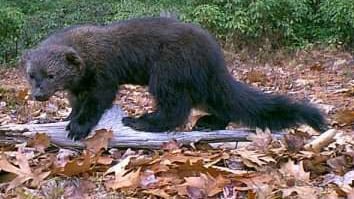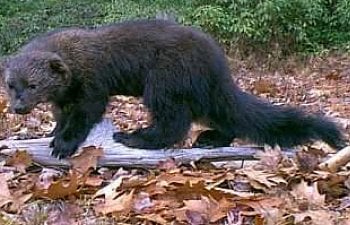
The fisher cat (Martes pennanti), also known as the "pekan cat", or "black cat", is a large, dark coloured, furry member of the weasel family. These forest dwelling mammals are active year round and mostly during the dawn and dusk hours of the day. Fishers are generalist predators. Their primary prey is hares and porcupines, but they are also known to feed on insects, nuts, berries, and mushrooms and on occasion carrion. Since they are solitary hunters and small in size, their prey is limited to birds and smaller mammals and unfortunately, these include our chickens.
DESCRIPTION
Adult males weigh from 7 to 12 pounds and may be 40 inches long, including their 13 to 15 inch tail. Adult females are smaller, weighing from 4 to 5.5 pounds. Extremely large male fishers may approach 20 pounds, but that is very unusual. They have short legs, small ears, and a long well-furred tail. Their color varies from dark brown to nearly black. Fisher fur is long and luxuriant. The males often have a "grizzled" appearance due to the many tri-colored hairs along their neck and shoulders. Fishers have large feet with five sharp toes, making them well adapted for walking on snow, climbing trees, and killing their prey.
RANGE
Fishers live in a band of forested habitat extending across North America. They do not occur on any other continent. In the east, they are found from Virginia north to Quebec and the Maritime Provinces of Canada. Males' territories are larger than females' and the sizes of these regularly patrolled areas vary according to the availability of prey species. A 10 square mile territory is typical for a female fisher and males commonly hunt a 30 square mile area. Circuits are irregularly patrolled although fishers travel pretty much in a straight line when they have determined to go to a certain location. Males usually pass through a given area in their territory about once every two weeks. Female circuits in winter usually vary from 3 days to a week.
METHOD OF KILL
Fishers are vicious predators who will raid chicken coops and kill numerous chickens in one attack. They may also try to remove some of them from the coop. They will eat the neck and head and may have the breast of the bird opened up as well.
PREVENTION AND TREATMENT
Fishers are a serious concern for chicken owners, as these animals can cause a lot of damage and heartache when they get to your flock. A determined Fisher cat will make an effort to gain access to your coop, so make sure your coops and runs are secure and the runs are fenced in with strong wire. The coops should have no small openings or weak spots where the fisher can squeeze through. If possible also secure the coop and run with electric fencing. Fishers can chew through wood, siding, and chicken wire to gain access, so fit an apron of hardware cloth and or welded wire around your run to deter them and bury it a few inches underground as well to stop them digging their way in. Also fit hardware cloth over any windows and ventilation holes in the coop as fishers are very good climbers and they can squeeze through very small gaps and openings. Therefore the top of the run should be ideally be covered as well.
Deterring these animals are tricky and they protected by law, so if you find a fisher on your property contact your local wildlife conservation office to find out if it is legal in your state/area before trapping/killing it.
For more information and discussions on fisher cats visit the Predators and Pests section of the forum.

